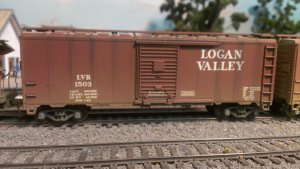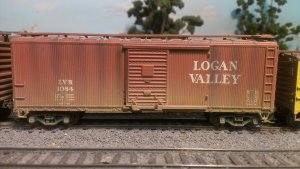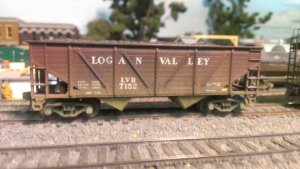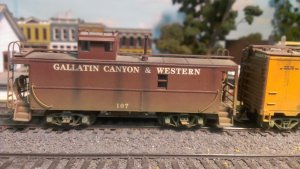Aerojet
Active Member
Curious how do you evaluate and buy your freight cars? Time period? Road name? Undecorated and you do the rest with your own paint scheme and decals? Or local freight seen in the area?
Okay I am a total foamer. I chase trains every weekend, and by now have over 4000 frames stored on both this box and several thumb drives. So for me when it came time to buy cars I have a real problem. Back in the 70's - 80's when I had stock in the Milwaukee Road and Western Pacific a lot of my cars reflected my investing trends. Still have quite a few WP cars on the pike, although it is now apart of the UP ... Milwaukee went down to the Soo, then the CP.
So following that, I have cars from all four someplace on the pike. Also the feeder roads, NP, CNW, CB&Q, GN, CP, CN. and others which go by here weekly.
Visable loads are another thing. A box car, covered hopper, reefer, or tank can be loaded or empty. You can't tell. But loads on open cars are another matter. Do you loads reflect what you see on the rails, or your time period, or pike's purpose? Or do you just stuff anything on the rails for fun?
Normally I get either make loads or buy loads which reflect what I see on the rails. Lumber on the big center spine cars, cement cans, pipes, always pipes, containers, both on well cars and flat cars, and of course auto racks. You have seen some of my auto racks, they are the 50's style with open decks and no roof. Besides they are 50 foot cars and go around 18 inch curves with no problem. You have seen me post out the 70 foot lumber wagon going around a tight curve into a tunnel.
I do have fun cars -- like a early 80's "missile" launcher on a flat car, that hardly ever gets rail time, but it does get off the shelf for a few days just for fun. My old Walthers craft cars like the Executive get out once in awhile along with the Oscar and Piker and their accompanying Hustler painted in Amtrash colors.
With over 40 years of building and rebuilding cars, collecting the things for road names and loads there are a good 54 cars around here which can go on and off the rails as needed.
As I said in an earlier post, one needs to keep the pike fresh. It gets boring watching the same handful of cars going around, getting switched and back out on the line. Cars should come on the rail, get worked, make a few days of trips, go thru the yards, then then go away. Just as they do in the prototype. Having a large fleet of cars allows that.
In time the same cars return to the pike and are worked again, while others take a long vacation either in the display case, or on the shelf until they are needed again. ALL MY CARS have KaDee couplers and metal trucks and all will run. I have no siding queens which cannot run on the pike. The static tracks are just another way or displaying cars, like the work train, until it is needed again. If you make your static tracks look right, it almost looks like they are sitting on a siding awaiting the call to the road...
Your opinions and ideas?
The Aerojet
Okay I am a total foamer. I chase trains every weekend, and by now have over 4000 frames stored on both this box and several thumb drives. So for me when it came time to buy cars I have a real problem. Back in the 70's - 80's when I had stock in the Milwaukee Road and Western Pacific a lot of my cars reflected my investing trends. Still have quite a few WP cars on the pike, although it is now apart of the UP ... Milwaukee went down to the Soo, then the CP.
So following that, I have cars from all four someplace on the pike. Also the feeder roads, NP, CNW, CB&Q, GN, CP, CN. and others which go by here weekly.
Visable loads are another thing. A box car, covered hopper, reefer, or tank can be loaded or empty. You can't tell. But loads on open cars are another matter. Do you loads reflect what you see on the rails, or your time period, or pike's purpose? Or do you just stuff anything on the rails for fun?
Normally I get either make loads or buy loads which reflect what I see on the rails. Lumber on the big center spine cars, cement cans, pipes, always pipes, containers, both on well cars and flat cars, and of course auto racks. You have seen some of my auto racks, they are the 50's style with open decks and no roof. Besides they are 50 foot cars and go around 18 inch curves with no problem. You have seen me post out the 70 foot lumber wagon going around a tight curve into a tunnel.
I do have fun cars -- like a early 80's "missile" launcher on a flat car, that hardly ever gets rail time, but it does get off the shelf for a few days just for fun. My old Walthers craft cars like the Executive get out once in awhile along with the Oscar and Piker and their accompanying Hustler painted in Amtrash colors.
With over 40 years of building and rebuilding cars, collecting the things for road names and loads there are a good 54 cars around here which can go on and off the rails as needed.
As I said in an earlier post, one needs to keep the pike fresh. It gets boring watching the same handful of cars going around, getting switched and back out on the line. Cars should come on the rail, get worked, make a few days of trips, go thru the yards, then then go away. Just as they do in the prototype. Having a large fleet of cars allows that.
In time the same cars return to the pike and are worked again, while others take a long vacation either in the display case, or on the shelf until they are needed again. ALL MY CARS have KaDee couplers and metal trucks and all will run. I have no siding queens which cannot run on the pike. The static tracks are just another way or displaying cars, like the work train, until it is needed again. If you make your static tracks look right, it almost looks like they are sitting on a siding awaiting the call to the road...
Your opinions and ideas?
The Aerojet





